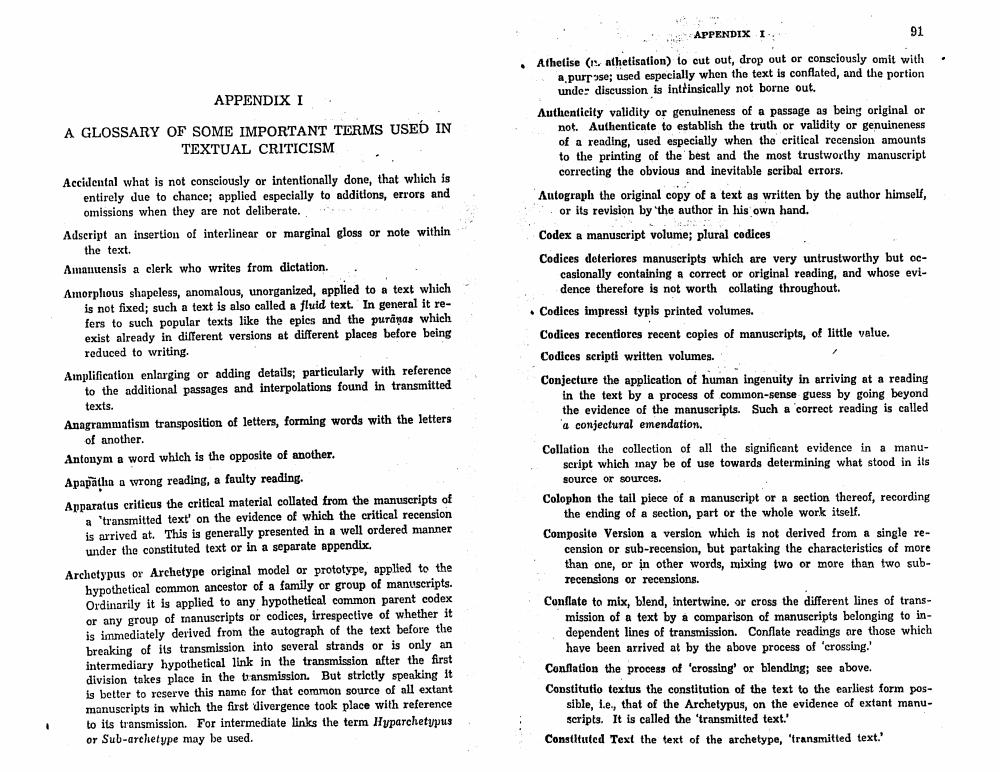________________ ... APPENDIX I., 91 APPENDIX I . A GLOSSARY OF SOME IMPORTANT TERMS USED IN TEXTUAL CRITICISM. Accidental what is not consciously or intentionally done, that which is entirely due to chance; applied especially to additions, errors and omissions when they are not deliberate. This Adscript an insertion of interlinear or marginal gloss or note within the text. Amanuensis a clerk who writes from dictation. . Amorphous shapeless, anomalous, unorganized, applied to a text which is not fixed; such a text is also called a fluid text. In general it refers to such popular texts like the epics and the puranas which exist already in different versions at different places before being reduced to writing. Amplification enlarging or adding details; particularly with reference to the additional passages and interpolations found in transmitted texts. Anagrammatism transposition of letters, forming words with the letters of another. Antonym a word which is the opposite of another. Apapatha a wrong reading, a faulty reading. Apparatus criticus the critical material collated from the manuscripts of a 'transmitted text on the evidence of which the critical recension is arrived at. This is generally presented in a well ordered manner under the constituted text or in a separate appendix. Archetypus or Archetype original model or prototype, applied to the hypothetical common ancestor of a family or group of manuscripts. Ordinarily it is applied to any hypothetical common parent codex or any group of manuscripts or codices, irrespective of whether it is immediately derived from the autograph of the text before the breaking of its transmission into several strands or is only an intermediary hypothetical link in the transmission after the first division takes place in the v:ansmission. But strictly speaking it is better to reserve this name for that common source of all extant manuscripts in which the first divergence took place with reference to its transmission. For intermediate links the term Hyparchetypus or Sub-archetype may be used. i Athetise (1. athetisation) to cut out, drop out or consciously omit with a purpose; used especially when the text is conflated, and the portion under discussion is intrinsically not borne out. Authenticity yalidity or genuineness of a passage as being original or not. Authenticate to establish the truth or validity or genuineness of a reading, used especially when the critical recension amounts to the printing of the best and the most trustworthy manuscript correcting the obvious and inevitable scribal errors. Autograph the original copy of a text as written by the author himself, 1. or its revision by the author in his own hand. Codex a manuscript volume; plural codices Codices deteriores manuscripts which are very untrustworthy but oc casionally containing a correct or original reading, and whose evi dence therefore is not worth collating throughout. * Codices impressi typis printed volumes. Codices recentiores recent copies of manuscripts, of little value. Codices scripti written volumes. Conjecture the application of human ingenuity in arriving at a reading in the text by a process of common-sense guess by going beyond the evidence of the manuscripts. Such a correct reading is called a conjectural emendation, Collation the collection of all the significant evidence in a manu script which may be of use towards determining what stood in its source or sources. Colophon the tail piece of a manuscript or a section thereof, recording the ending of a section, part or the whole work itself. Composite Version a version which is not derived from a single re cension or sub-recension, but partaking the characteristics of more than one, or in other words, mixing two or more than two sub recensions or recensions. Conflate to mix, blend, intertwine. or cross the different lines of trans mission of a text by a comparison of manuscripts belonging to independent lines of transmission. Conflate readings are those which have been arrived at by the above process of 'crossing.' Conflation the process of 'crossing' or blending; see above Constitutio textus the constitution of the text to the earliest form pos sible, i.e., that of the Archetypus, on the evidence of extant manu scripts. It is called the 'transmitted text.' Constituted Text the text of the archetype, 'transmitted text.'




